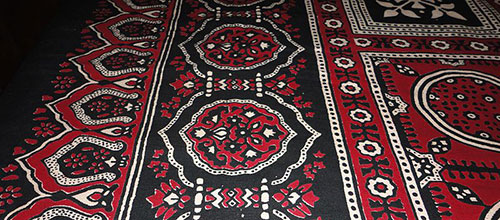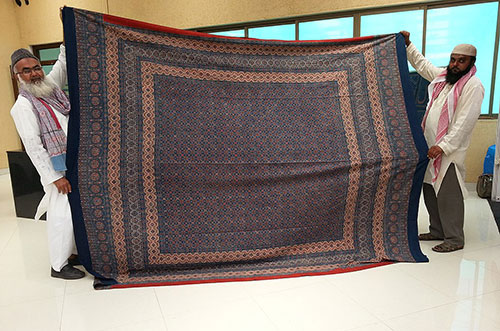 The tradition of block printing on fabric exists in Pakistan for 5,000 years. Such traditional garments as an ajrak shawl decorated with unimaginably beautiful patterns are one of the symbols of Pakistani clothing culture. Of course, modern Pakistanis prefer to wear contemporary clothes in daily life, cheap and easily industrially made. Although, there are still manufacturers in this country who produce handmade ajrak shawls and other garments embellished with block-printed traditional designs. How do they do it? Let’s find out.
The tradition of block printing on fabric exists in Pakistan for 5,000 years. Such traditional garments as an ajrak shawl decorated with unimaginably beautiful patterns are one of the symbols of Pakistani clothing culture. Of course, modern Pakistanis prefer to wear contemporary clothes in daily life, cheap and easily industrially made. Although, there are still manufacturers in this country who produce handmade ajrak shawls and other garments embellished with block-printed traditional designs. How do they do it? Let’s find out.
The ajrak or ajrakh is a form of block printing typical for some regions of Pakistan and India. This word is also used to call the traditional shawls made using the block printing technique. There is a myriad of patterns created by block printing and the process is rather simple but time-consuming. It’s like a meditation of sorts – you cover a wooden stamp with paint, put it to the cloth, hit the stamp with your palm so that the paint goes deeper into the fabric, and repeat again and again.
Pakistani ajrak block printing has its peculiarities. For example, the artisans soak the fabric in camel dung and use cow dung during dying. They do everything by hand – from a blank piece of cotton to the ready shawl. And the knowledge about this process has been passed from one generation to the next for centuries. The craftsmen who produce ajrak block printed shawls work in this craft for their whole life, from childhood and as long as they are able to work.
How are ajrak shawls made?
The artisan takes a plain white cotton cloth called “kora” in Pakistan. He goes to a stream and washes the stiff cotton in the water and slaps it against a stone or a brick wall many times to make the fabric softer and prepare it for dyeing. Then, the cloth is spread out and dried in the sun.
The next step is to prepare a specific mixture called “saaj” that consists of camel dung, water, baking soda, and mustard oil. The real handcrafted ajrak shawl always has a musty smell that comes from this unique paste. But it works perfectly to give the fabric nice colors that pop.
The artisan soaks the cloth in saaj, wrings it, dries, and soaks again – at least 4 times. It’s needed to achieve the right amount of paste inside the fibers. And then, the cloth is washed in the stream again to get rid of the dung leftovers.
When the fabric is dried, the craftsmen always leave some amount of moisture in it, never letting it fully dry. This process of soaking and drying the cloth lasts for 4-5 days.
After that, it is ready for stamping. The artisans use wooden stamps to apply the paint. There are only 3-4 traditional patterns that are still used. Other patterns are modern, customized by the individual workshop.

Photo from Wikipedia.org
After the print is applied, the artisan adds with the help of a stamp an herbal paste with cow dung to specific zones that will remain undyed. The paste sticks to the fabric and the dye doesn’t get inside the fibers.
The prepared cloth is then dipped into barrels with natural liquid dye, soaked, dried in the sun, and washed again to get rid of the excess dye.
Or the craftsmen mix hot water with alizarin pigment and an herb called “sakun” to give the fabric a nice yellow shade. A sakun has a bright sunny-yellow color. Ajrak shawls are dipped in this boiling mixture and left to simmer for an hour.
Handmade ajrak shawls are usually colorful and vivid – navy blue, maroon, crimson, kurkuma yellow, etc.
A skilled craftsman can block print 10-12 shawls a day. Just imagine the amount of work – practically all the surface of the cloth is covered with patterns, often several times because every color is applied separately, and the size of a stamp is only a few square centimeters.
It takes almost a month to create one ajrak shawl. And a large amount of hard work. Accordingly, the price of such a handmade shawl is 50 times higher than a simple factory-made shawl, but it’s so worth it, as it’s skillfully handmade. But many Pakistani workshops that produce ajrak shawls are on the brink of existence, sadly.

Photo from Wikipedia.org
The difference between a machine-made and a handmade ajrak exists. The colors on a real handcrafted shawl never get blank – due to the saaj paste, by the way. They use natural herbs and spices to dye the cloth, no chemical dyes are applied, so a real ajrak shawl doesn’t cause allergies and skin problems. These traditional shawls are absolutely eco-friendly and bio-degradable.
It’s so sad that ajrak shawls today aren’t as popular as they used to be. For several millennia, men in this part of the world wore these bright handmade shawls, rulers used them, ordinary Pakistanis used them. And even today, some still do, but this ancient craft is disappearing inch by inch – cheap industrially-made garments replace real handcrafted ones that require a lot of hard work. We truly hope this wonderful tradition to produce ajrak shawls using the old techniques will survive.


